Don't wanna be here? Send us removal request.
Text
Reflection
Overall, I consider the project a success; though not every single one of the initially established tasks was completed, I achieved the fundamental goal of delivering the narrative through an interactive medium while also utilising my skills with Unity and C# programming. I made an attempt at digital drawing and animation, which was new and exciting for me but also presented a challenge. I also included a few features in this game that I had not tried to implement in previous projects, such as narrative text appearing at certain points throughout the level and programming a “friendly” NPC to fight the enemies. The project was submitted on time, and all the work has been successfully documented. Regarding the documentation of work, one practice that I have engaged with in this project is leaving explanative comments throughout my code, so as to indicate on specific lines of code or specific methods what their purposes are. I found this to be quite effective for multiple reasons; primarily to provide a clear explanation for assessors and others who might view it as to what the code does, but also for my personal reference should I elect to use similar programming techniques in future projects (or even the future of this project).
A decision I made early on in development was that rather than creating an entire game from start to finish in the allotted time, I would create the first version of a larger-scale project. While this does give the impression of incompleteness, it allows me to pursue a professional goal of mine; to create a game of my very own, on an independent basis. That is to say, while I have been completing this project within university guidelines and with the deadline in mind, I fully intend to create a full indie 2D platformer using what I have created in this project as the foundation. I have already established the narrative and fundamental elements, which makes it far more viable for me to expand on it in the future.
If I were to complete a similar project again in the future, I would improve upon my efforts by planning ahead of time which assets I would create myself, and which ones I would use that are not solely my intellectual property. I expect that this would substantially improve my time management of the project, thus it would be more viable for me to implement more interesting features into it. Additionally, I would begin to explore the inclusion of user interface elements such as menus and a GUI during the actual playtime, to improve the overall user experience and increase the clarity of what I wish to communicate to the players via the game.
0 notes
Text
Referencing Materials
No online tutorials were used over the course of this project – all code present in the project is original, with some being reused (with alterations) from previous projects I have completed with Unity and C# (such code is also original, all my own work).
All written text in the game (narration and tutorial) is original.
With the exceptions of the artwork and animations for the Tarantech Walker and Tarantech Jumper, none of the visual assets are owned by me (all programming done for the animations was done personally, however).
All audio files used were composed and arranged by Matt Burrows and used with his full permission.
Harvard Referencing:
Game Art 2D. (2019). Free Game Assets. [online] Available at: https://www.gameart2d.com/freebies.html [Accessed 9 May 2019].
Burrows, M. (2019). MATT BURROWS. [online] MATT BURROWS. Available at: http://www.mattburrowssounddesign.co.uk/ [Accessed 9 May 2019].
0 notes
Text
Remaining Documentation
After realising that this blogging platform posts my uploaded images in extremely poor quality, I’m leaving a google drive link here that will contain all screenshots and a couple of videos that showcase the working process. The script files are commented with explanations, and are identical to what is present in the assets folder in the digitally submitted project files on Studynet. I will post 2 more things after this; a section on referencing my used materials, and my 500 word reflection.
Google Drive link to evidence of work:
https://drive.google.com/drive/folders/1V1VODPe7xI6Y0D0pM_bDdfRzqfgGWcb0?usp=sharing
Link to a Youtube video showcasing the completed demo:
https://youtu.be/YQjIUN2FFbI
0 notes
Text
Task Priority
Considering how much work there is still to be done within the time frame (i.e. before the deadline), I have decided to give priority to implementing functional features into the game over visually designing characters and environments. This is because I have far less experience in digital drawing than in using the Unity Editor and C#. Specifically, the tasks I expect to have completed by the time I submit the project are;
-Enemy programming logic (movement, attacks)
-Player control (movement, healing powers)
-Ally NPC logic (movement, attacks)
-Placeholder visual assets (environmental, background, entities, projectiles)
-A way to cohesively display the introduction to the story (text displayed on the screen as the player walks through the tutorial level)
Additional task to complete before the deadline IF it is feasible:
-Fully programmed boss fight against a large enemy that has a combination of abilities displayed by the regular enemy units
0 notes
Text
Visually Designing the Protagonist
The functional and narrative designs of the player character have been established, so the final piece left for it is the visual design. Initially I tended towards a more generic humanoid design, but then realised that this could potentially detract from the uniqueness of the character. For this beginning stage of development, I believe a reasonable design choice is to draw out a minimalist, simple looking character until I can definitively decide on a more substantially developed design.
0 notes
Video
tumblr
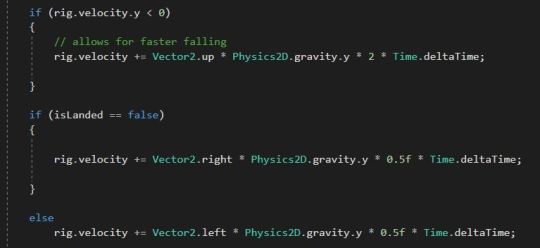
Version 2 of the Jumper’s animation, and revised code. This allows it to jump in an arc, rather than rising vertically and falling diagonally. The isLanded boolean I created is responsible for determining which direction the jump takes.
0 notes
Video
tumblr
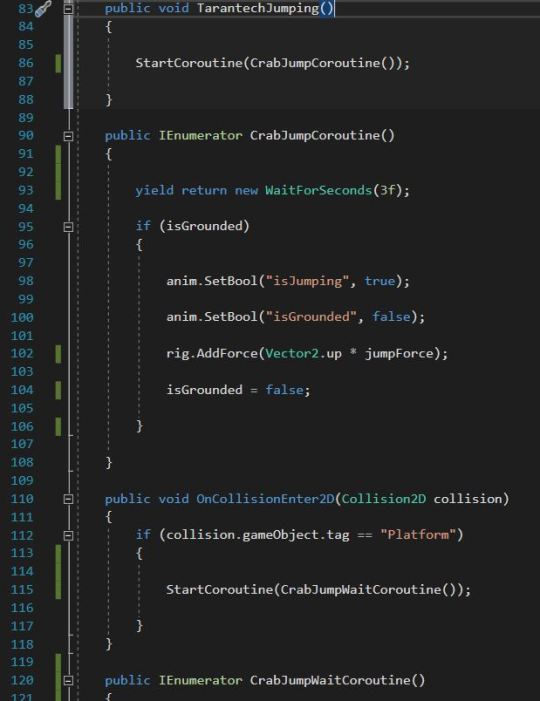
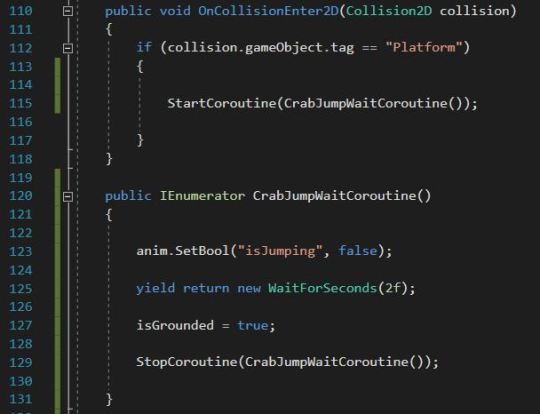
First version of the jumping animation for the Tarantech Jumper! As with the walker, I’ll be making improvements to the animation. I also want the jump to be directional in an arch rather than vertical.
0 notes
Video
tumblr
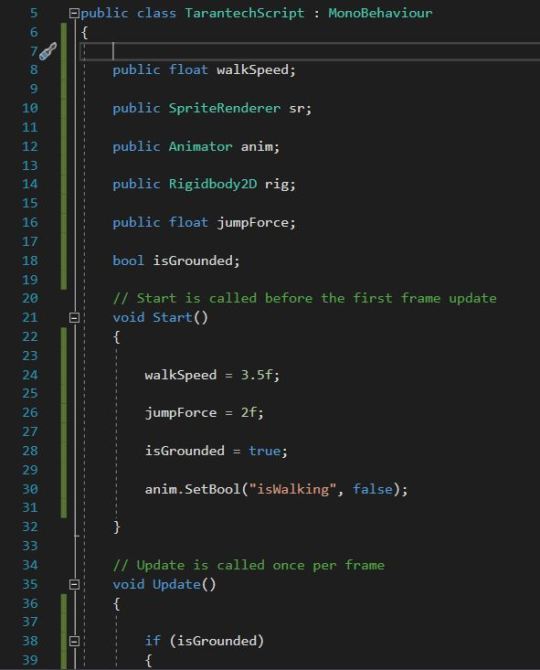
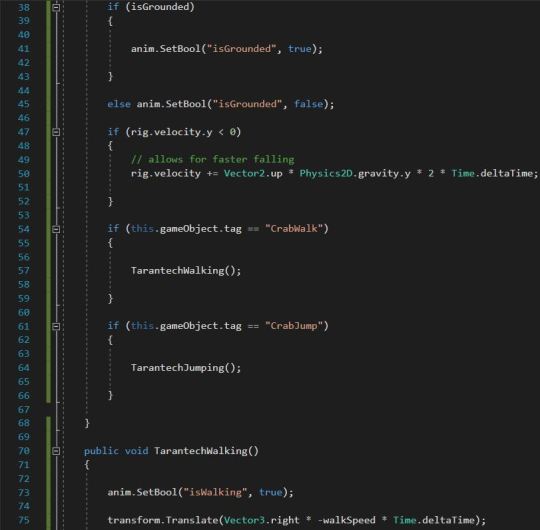

First version of the walking animation for the Tarantech Walker! (and the code to accompany it)
I’ll be making improvements to the animation and adding a control function to the walking path, so it goes back and forth between points rather than simply walking in one direction.
0 notes
Video
tumblr
I dubbed the enemy unit “Tarantech”, and showcased the process of drawing the character digitally! This was my first time drawing a digital design from scratch on Adobe Illustrator, and I enjoyed it more than I expected!
0 notes
Photo

Considering the setting of the game will be in a “dystopian” sci-fi environment, I want the enemy units to be robotic. For quite some time, I couldn’t decide on exactly what form the enemy units would take.
In a recent update to my favourite game to date, Warframe, a new type of enemy was added called “raknoids” which resemble robotic spiders with additional features. I will be taking inspiration from the physical form of the raknoids, more specifically the strongest of their kind called the Profit Taker Orb (depicted in the image above).
The primary reason why I will be taking inspiration from other games for visual assets is because creating them on my own would be quite intensive given my lack of experience in that field. Other reasons include my appreciation for the aesthetics of other game titles, and my ability to adapt a pre-existing idea in an effective manner.
Reference: Digital Extremes, 2018, Warframe (digital), PC/Xbox 1/PS4/Nintendo Switch
0 notes
Text
Planning development
Given the time constraints placed on this project, I have decided that it is unreasonable to try and complete the development of a full-length RPG before the project deadline. What I have set myself to complete is the first “chapter” of the story, with plans to continue developing the game as an independent project in the future. This allows me to give the assignment hand-in more substance and depth, since a single chapter will not represent the entirety of the game, but it will reflect the quality of what I wish to produce for the project in the long term. Chapter 1 will include the full-length tutorial level which also introduces the narrative, and I will include at least 1 more level which will contain a boss fight to conclude that section of the game.
0 notes
Photo
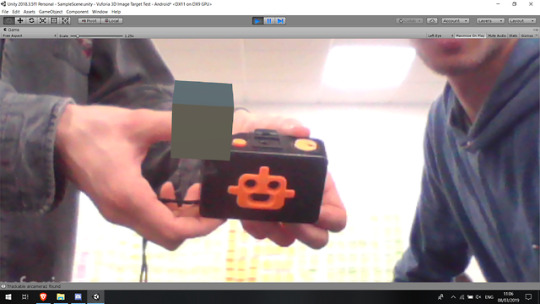
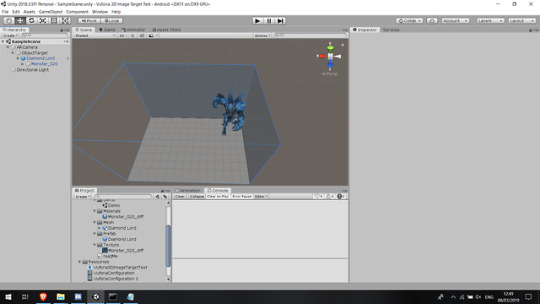
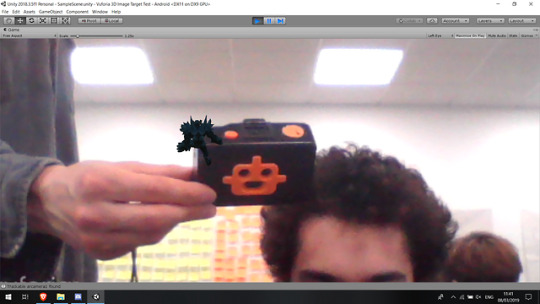
After adding the 3D object to a Vuforia database, and downloading it as a Unity package file, I imported it into my project so it would be the recognised image target (the selected type was “3D Scan” rather than “2D Image Target”). Then I added a simple cube as a child of the ObjectTarget of the AR Camera, so it would be displayed on top of the 3D object.
Then I imported a 3D model “Diamond Lord” from the Unity Asset Store (https://assetstore.unity.com/packages/3d/characters/humanoids/diamond-lord-139721) and replaced the cube with it, after resizing the prefab.
0 notes
Text
Unity + Vuforia Tutorial (Part 1)
Today we will be learning how to use a 3D object as an image target. This is particularly useful for me as I have only previously used Vuforia to work with 2D image targets, and at some point during my Independent Project I will have to create AR buttons in Unity that are placed in areas of a specific 3D object.
0 notes
Text
Unreal vs Unity
Overall I prefer using the Unity engine because scripting with actual programming languages is the focus of it, whereas Unreal focuses on node-based programming. The issues with this are the limits imposed upon game designers, namely the fact that with Unreal’s node-based programming you have to use premade functions rather than writing your own, which severely restrains creativity. Additionally, using the nodes seems unnecessarily complicated, and I would only recommend it to someone who has never used a scripting language before.
The only real benefit of using the Unreal engine that I can see is the increased graphical capability, and I would rather make slightly less aesthetically pleasing games if it means keeping my working process relatively uncomplicated. I believe that while the visual appearance of a game is important, it shouldn’t really be the first priority or main focus of a game.
Gamers can enjoy what they want, of course; but I wouldn’t want my audience to be the kind of people who care about visual appearance more than important factors such as gameplay or narrative.
0 notes
Text
Unreal Engine Tutorial
-Determine functions before visuals, create your “blocking environments” first
-For textured objects, don’t use the scaling tool because it will mess up the textures, use the geometry editing tool to stretch or compress the dimensions while retaining texture quality.
-Unreal’s equivalent of prefabs are ‘blueprint class’ objects.
-You can snap game objects to the grid.
-Game objects are exportable as .fbx files
0 notes
Text
Ideas for a ‘tutorial’ level, and the beginning of the story
The first level that the player will play through will serve as an introductory experience to the story and mechanics of the game. The player will be allowed to explore controls while being inducted into the narrative, and the more prevalent features of the game will be exposed gradually over the course of the level.
An draft of the order in which things will appear in the tutorial level:
-The protagonist ‘awakens’ at a set location (as a story element, the player may have been imprisoned by the antagonist’s forces) and the player gains control over the character.
-Walking controls are introduced, as the character traverses a flat terrain (story element; a mysterious voice speaks to the player, explaining their situation to them).
-Jumping controls are introduced, as the character is faced with a tall step that requires them to jump (story element; the voice continues their exposition).
-A single, immobile enemy is encountered (possibly a grounded robotic turret that fires lasers slowly). At this point, the player is given access to their personal shield, and are instructed to make their way past the enemy while shielding attacks as needed.
-The player then leaves the building where they began the level in, and the voice explains to them that they were rendered comatose in the prison many years prior. The site had been almost completely abandoned since, save for the one laser turret that was encountered earlier. The only reason the player had survived for so long is because they have innate powers of healing.
-As the player continues to move away from the building, they are told about how the antagonist developed a disease which spread over many years across the population of the area. The reason the player was imprisoned was because they had the ability to cure the affliction, which put a dent in the antagonist’s plans. There were many more individuals with this ability, but their fates at the hands of the antagonist’s forces are unknown by this point.
-The player then encounters their first ‘afflicted’, and are given access to the healing power to restore the NPC to good health. The NPC then thanks the player for their help, draws a staff or baton of some kind, and says they’ll travel alongside the player for the remainder of the area and defend them against any enemies they encounter.
-A walking robotic enemy approaches the two characters a short distance later, and the healed NPC begins striking the robot with the staff/baton. The robot fires lasers at the NPC, dealing some damage, but is soon defeated.
-The end point of the level is then reached, and the NPC vanishes as the end-of-level screen appears. The player then gets the option to either continue to the next level, or to quit the game for now (their level progress will be saved upon quitting using the Unity PlayerPrefs function, unless they choose to restart their journey from the beginning).
-The protagonist/player doesn’t find out until much later in the game, but the mysterious voice that’s communicating with them belongs to the individual who is responsible for discovering the healing powers that were once possessed by so many. That individual had their powers stripped from them by the antagonist, but they can still communicate from afar to help guide the protagonist on their quest.
0 notes
Text
Player shielding
Since the player character’s powers are defensive rather than offensive, I intend to give the player a personal shield that can be toggled with a key press. The player can’t move around while using the shield, and the shield depletes over the duration of its use and requires time to recharge. The shield can protect against damage from enemy attacks, but not against damage from environmental hazards.
0 notes